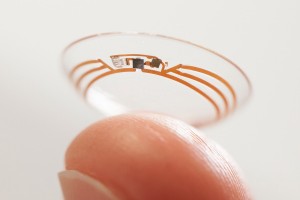Sight For Sore Eyes
Imagine approaching the intersection of a busy road, but you cannot see a thing. The world is dark, and you must depend on your other senses to get yourself across this road alive. Would you cross? Google’s new smart contact lenses say yes.
The Idea
The original idea behind the development of these smart lenses was to help persons with diabetes. Diabetics deal with daily emotional and physical struggles of having to constantly check their glucose levels, prick their fingers, and get insulin shots. In order to try and relieve this stress, Google decided to insert a tiny chip on a contact lens, which is able to measure the glucose content in a person’s tears. If the glucose levels were to suddenly drop or rise, the lens would alert the person through an indicator such as a blinking light.
Taking this idea a step further, Google designed lenses that are applicable to those who experience a loss of sight. The wearer has the ability to control the lenses with eye gestures, such as blinking, in order to take a picture.
Helping the Visually Impaired
This technology can be used to detect light, colors, patterns, objects, and motion through images that are gathered through the lens. Combined with face recognition software, it would allow a blind person to identify people they see without even hearing their voices. Even for those with perfectly healthy sight, this is a very powerful tool due to the ability to process data, both locally and remotely, through the lens.
For those who are only partially visually impaired, parts of their visual field that are in their blind spots can be digitally stored. This data could then be displayed at a later point and would allow them to sense more. These images can be easily displayed on a smartphone or tablet.
This technology would be particularly useful for people with conditions such as hemianopia, scotoma, and quadranopia, because although part of the image they see may be blurry due to lesions in their primary visual cortex, a picture of a scene can be rearranged until the patient has the ability to see and fully comprehend the full image.
Let’s return to the intersection example. While approaching this intersection, imagine that the camera in your eye is rapidly processing the nearby field, determining whether there are cars speeding by. Once it detects that the road is clear, the wireless chip sends an alert to the your smartphone to let you know that it is now safe to pass. This technology communicates visual information through auditory channels, allowing individuals to use senses other than sight alone.
More specifically, these lenses are applicable to those with presbyopia (no longer being able to view objects closely, which results from a loss of elasticity in the lens of the eye). Research suggests that people with presbyopia should have the ability to read or see close up using the Google contact lenses because they “provide accommodative vision correction to help restore the eye’s natural autofocus on near objects in the form of an accommodative contact lens or intraocular lens as part of the refractive cataract treatment.”
Future Directions
There are endless possibilities for how this smart lens can help people live more comfortably, even without the full use of their vision. Unfortunately, there are a few caveats to this invention. People with physical damage to their eyes may not be able to wear contact lenses, making this device more applicable to those who lost their sight due to brain damage, not direct eye damage. Also, this technology is more desirable for discrete face recognition and documentation purposes, perhaps to be used by law enforcement, rather than to help the visually impaired. We don’t yet know what will come out of this work-in-progress, but it is certain to enhance the capabilities of the eye.
Sources
Grandoni, D. (2014, April 14). Google Wants To Put A Camera On Your Eyeball. Retrieved September 24, 2015, from http://www.huffingtonpost.com/2014/04/14/google-eye-camera-contact-lens_n_5148332.html
Mlot, S. (2014, April 15). Google Patent Tips Smart Contacts With Cameras. Retrieved September 24, 2015, from http://www.pcmag.com/article2/0,2817,2456617,00.asp
Otis, B., & Parvis, B. (2014, January 16). Introducing our smart contact lens project. Retrieved September 24, 2015, from http://googleblog.blogspot.com/2014/01/introducing-our-smart-contact-lens.html
Prigg, M. (2014, July 15). Google’s smart contact lens is coming to an eye near you: Lenses for diabetics and the farsighted to go into production. Retrieved September 24, 2015, from http://www.dailymail.co.uk/sciencetech/article-2693326/Googles-smart-contact-lenses-coming-eye-near-soon-Lenses-diabetics-farsighted-set-production.html
Ward, J. (n.d.). The Student’s Guide to Cognitive Neuroscience (3rd ed., p. 113). London: Psychology Press.

